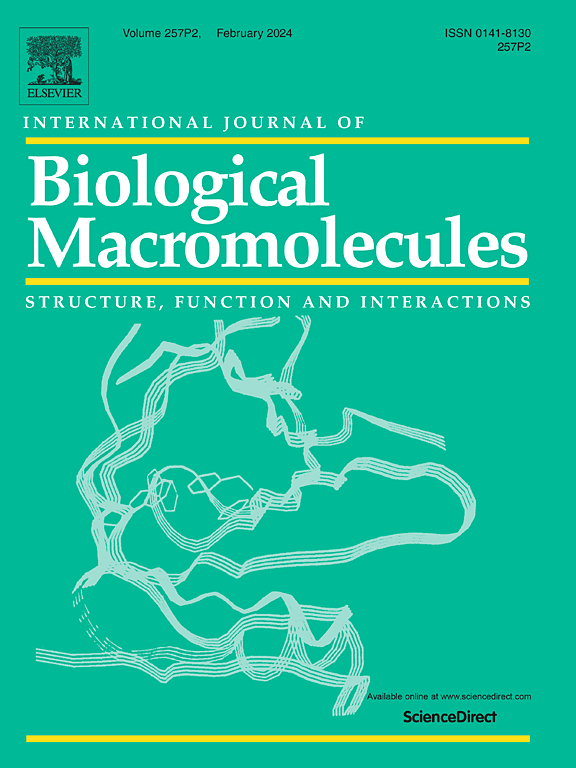Glutaraldehyde-crosslinked magnetic chitosan nanocomposite for efficient Cr(VI) removal: A sustainable approach to aquatic remediation
IF 8.5
1区 化学
Q1 BIOCHEMISTRY & MOLECULAR BIOLOGY
International Journal of Biological Macromolecules
Pub Date : 2025-04-23
DOI:10.1016/j.ijbiomac.2025.143459
引用次数: 0
Abstract
Hexavalent chromium (Cr(VI)) is a highly toxic pollutant in aquatic environments, posing serious threats to ecosystems and human health. This study aims to develop an effective adsorbent for the removal of Cr(VI) from water. A novel magnetic chitosan-based nanocomposite (Fe₃O₄@MCS) was synthesized by in situ embedding of Fe₃O₄ nanoparticles into a chitosan matrix, crosslinked with glutaraldehyde, and further modified with ammonia via a Schiff base reaction. The material was thoroughly characterized using FTIR, XPS, XRD, SEM, TEM, EDX, and VSM. Adsorption experiments showed that Fe₃O₄@MCS achieved a maximum Cr(VI) uptake of 221.4 mg/g under optimal conditions (pH 4.0, 25 °C, 10 mg dosage, 120 min contact time), with 100 % removal efficiency at initial concentrations up to 50 ppm within just 15 min. The adsorption followed pseudo-second-order kinetics and fitted well with the Langmuir isotherm model (R2 = 0.999), indicating monolayer adsorption behavior. The removal mechanism involves electrostatic interactions between HCrO₄- and protonated amine/hydroxyl groups, followed by Cr(VI) reduction to Cr(III), as confirmed by FTIR and XPS analyses. Fe₃O₄@MCS also demonstrated excellent magnetic separability and reusability, maintaining over 90 % removal efficiency after five adsorption–desorption cycles. These findings highlight Fe₃O₄@MCS as a highly promising adsorbent for Cr(VI) remediation in water treatment applications.
戊二醛-交联磁性壳聚糖纳米复合材料高效去除Cr(VI):一种可持续的水生修复方法
六价铬(Cr(VI))是水生环境中一种剧毒污染物,对生态系统和人类健康构成严重威胁。本研究旨在开发一种去除水中铬(VI)的有效吸附剂。将Fe₃O₄纳米颗粒原位包埋在壳聚糖基体上,与戊二醛交联,再通过席夫碱反应与氨进行改性,合成了一种新型磁性壳聚糖基纳米复合材料Fe₃O₄@MCS。利用FTIR、XPS、XRD、SEM、TEM、EDX和VSM对材料进行了表征。吸附实验表明,Fe₃O₄在最佳条件下(pH 4.0, 25℃,10 mg,接触时间120 min), Fe₃O₄对Cr(VI)的最大吸收率为221.4 mg/g,在初始浓度为50 ppm时,吸附时间为15 min,去除率为100%。吸附符合准二级动力学,符合Langmuir等温线模型(R2 = 0.999),表现为单分子层吸附行为。FTIR和XPS分析证实,该去除机制涉及到HCrO₄和质子化胺/羟基之间的静电相互作用,随后Cr(VI)还原为Cr(III)。Fe₃O₄@MCS也表现出优异的磁可分离性和可重复使用性,经过5次吸附-解吸循环后,去除率保持在90%以上。这些发现表明Fe₃O₄@MCS是一种非常有前途的水处理Cr(VI)修复吸附剂。
本文章由计算机程序翻译,如有差异,请以英文原文为准。
求助全文
约1分钟内获得全文
求助全文
来源期刊
CiteScore
13.70
自引率
9.80%
发文量
2728
审稿时长
64 days
期刊介绍:
The International Journal of Biological Macromolecules is a well-established international journal dedicated to research on the chemical and biological aspects of natural macromolecules. Focusing on proteins, macromolecular carbohydrates, glycoproteins, proteoglycans, lignins, biological poly-acids, and nucleic acids, the journal presents the latest findings in molecular structure, properties, biological activities, interactions, modifications, and functional properties. Papers must offer new and novel insights, encompassing related model systems, structural conformational studies, theoretical developments, and analytical techniques. Each paper is required to primarily focus on at least one named biological macromolecule, reflected in the title, abstract, and text.

 求助内容:
求助内容: 应助结果提醒方式:
应助结果提醒方式:


